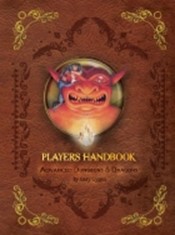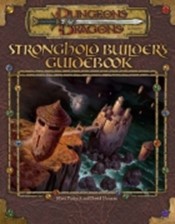Wow, didn’t expect these this week:
 The AD&D Player’s Handbook is one of the true classics of the Dungeons & Dragons line. Gygax wrote it to update and consolidate the system after the original D&D books had spawned a number of (occasionally contradictory) supplements and new classes in magazine articles. The result is brilliant. Although the DMG is praised more highly, for my money, the original Players Handbook is the much tighter-written book. Of particular interest are the later sections offering advice on adventuring, which offer a lot of insight into the early days of D&D.
The AD&D Player’s Handbook is one of the true classics of the Dungeons & Dragons line. Gygax wrote it to update and consolidate the system after the original D&D books had spawned a number of (occasionally contradictory) supplements and new classes in magazine articles. The result is brilliant. Although the DMG is praised more highly, for my money, the original Players Handbook is the much tighter-written book. Of particular interest are the later sections offering advice on adventuring, which offer a lot of insight into the early days of D&D.
A couple of oddities exist in the text, thanks largely to the way the system was written: at no point did Gygax ever have a “finished” AD&D as he was always tinkering with the system, and so the Players Handbook introduces AC 10 – no armour was AC 9 in both the original game and the Monster Manual – and the Monk is described as attacking as a thief; this was upgraded to attacking as a cleric in the DMG.
There are also quite a number of references to modifiers for parrying, initiative from encumbrance and the like that are never spelled out in the DMG, but have spawned numerous house rules over the years.
The book isn’t perfect, but it’s worth picking up for a look at one of the best expressions of the game. (It still has my favourite take on the Illusionist class, by the way!)
 The other new release of note is the Stronghold Builder’s Guidebook from 3E. This is likely to never be described as the best book of the D&D line, but my group had a lot of fun with it. It gives you something to spend your money on: a stronghold. The stronghold could be anything: a keep, a fortress, a house, a tower, a hidden thieves’ guild…
The other new release of note is the Stronghold Builder’s Guidebook from 3E. This is likely to never be described as the best book of the D&D line, but my group had a lot of fun with it. It gives you something to spend your money on: a stronghold. The stronghold could be anything: a keep, a fortress, a house, a tower, a hidden thieves’ guild…
What the book gives you are a lot of ideas for what goes in the stronghold: armouries, barracks, guest bedrooms, laboratories and the like, and a system for determining how much all of it costs. After selecting the elements, you have a rough idea of how much space it takes up so you can map it out and then build it!
The book doesn’t cover any of the later play that revolves around a stronghold (such as defending it from attack or the like), but the cool things you can build were enough to keep my players entertained and fuelled an entertaining portion of the campaign as they sought to make their dreams reality. There’s little rules-specific material here, so I’d have little problem using it in my 5E game – although I might need to adjust the costs a little. I haven’t really looked at how much the 3E and 5E economy differ yet!
